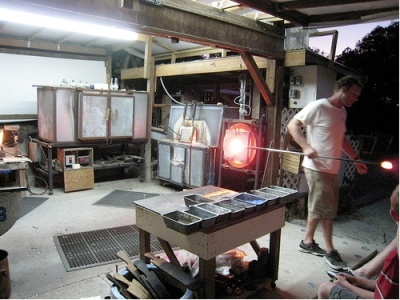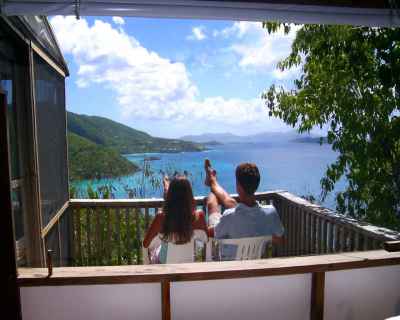 The glass shop at Maho Bay where recycled bottles are turned into souvenirs and sculpture.
The glass shop at Maho Bay where recycled bottles are turned into souvenirs and sculpture.
In 1975, when eco-tourism pioneer Stanley Selengut signed a 37-year lease to create Maho Bay Camps, a budget resort in the Virgin Islands, the end date on the contract seemed so far in the future, it wasn’t worth thinking about. As the years passed, his attention turned to the environment, and Selengut found cutting-edge ways to turn hospitality into an eco-friendly pursuit thanks to a recycled glass art studio, one of several initatives that demonstrated a commitment to sustainability years ahead of the rest of the hotel industry.
Unfortunately for Selengut, his innovative resort – along with the aptly-named “Trash to Treasures” art center – could be in serious trouble. His lease on the land expires in 2012, and if he goes, Maho Bay goes with him.
“At the time, 37 years seemed like an eternity,” says the 80 year-old resort founder. That lease expires on July 31, 2012, at which point the land will go up on the market for commercial ventures – likely candidates include a pricey vacation resort or a subdivision.
 The view from the resort's deck reveals the resort's pristine surroundings.
The view from the resort's deck reveals the resort's pristine surroundings.
Today, the resort stands as one of most highly praised in a new breed of eco-tourism destinations, focusing on low-impact, low-budget travel against a backdrop of pristine flora and fauna, with some of the most breathtaking views on the island of St. John. Guests reside in modest “tent-cabins,” connected by raised walkways, and spend the days relaxing, scuba diving, practicing yoga – or, if they’re so inclined, honing their skills in the craft center with paints, clay or glass.
The Trash to Treasures glass studio has generated buzz in the hotel industry wiht its full-service recycling center that turns glass waste into useable material thanks to two full-time glass artists who work with resort guests and on their own projects. “Around here, you can’t collect the glass waste and take it anywhere that will make use of it,” says Selengut. “What we do is special because it cuts waste, saves on costs and even creates jobs.” Guests enjoy daily glassblowing demonstrations in the outdoor studio, and hands-on glassblowing classes are offered at night – at least while the lease lasts.
Selengut’s plight has attracted wider attention from the environmental movement. The Trust for Public Land, a national, nonprofit conservation organization dedicated to protecting land for public use, has launched a campaign to save Maho Bay. If it succeeds in raising the necessary funds, it could purchase the land, enabling the eco-resort to continue operations in its current form.
It might sound like a long shot in the current economic climate, especially given the trust fund’s reliance on private donations and philanthropy, but Selengut remains ever-hopeful. “I think our chances are pretty good,” he says. “Certainly better than even.” He explains that the Virgin Islands National Park comprises most of the land surrounding the resort, which could cause major headaches for contractors looking to construct a large vacation destination. Buyers would also have to contend with the ruins of Maho’s many buildings, sewage treatment centers and extensive walkways, which could pose a major liability risk.
But fear not, glassblowers – if Maho Bay cannot be saved, the Trash to Treasures art center will live on at Maho’s sister resort, the Estate Concordia Preserve, a similarly eco-minded destination on the sunny southeastern side of the island. Either way, Selengut looks forward to upgrading the studio with more sophisticated equipment and larger facilities to accommodate more artists at once.
“We’ve done some great things with glass in the last few years, and learned so much,” he says. “We’d really like to take it to the next level, one way or another.”
—Brett Nuckles


